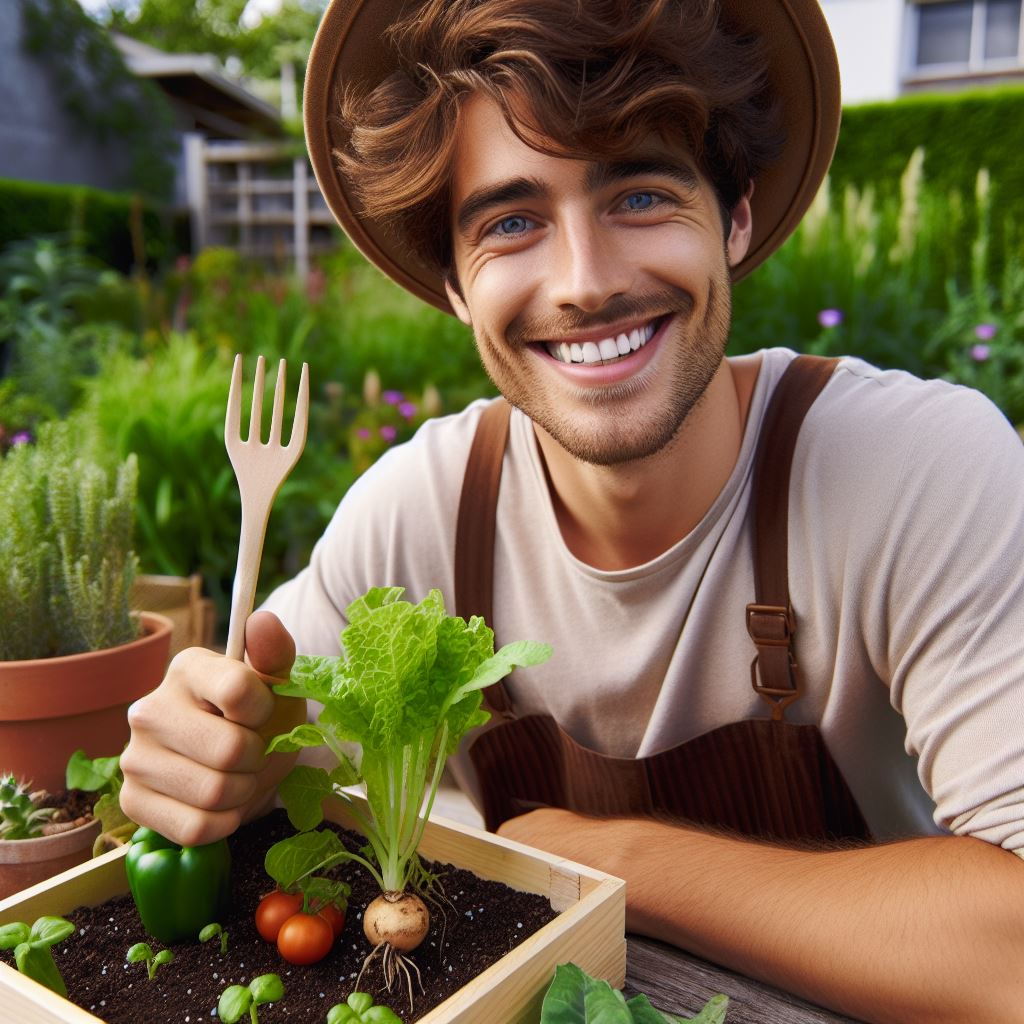Organic Gardening: Grow More in Less Space
Last Updated on March 2, 2024
Introduction
Organic gardening is a practice that is gaining popularity due to its importance in promoting sustainable agriculture and reducing environmental harm.
By using natural methods to control pests and diseases, organic gardening eliminates the need for harmful chemical pesticides and fertilizers.
This significantly reduces pollution and protects the health of both humans and the ecosystem.
One of the main advantages of organic gardening is the ability to grow more in less space.
This is especially beneficial for individuals with limited gardening space, such as those living in urban areas or apartments.
By utilizing vertical gardening techniques, raised beds, and container gardening, it is possible to maximize yields in small areas.
Growing more in less space also leads to increased productivity and efficiency.
By carefully planning and organizing the garden layout, every inch can be utilized effectively.
This means that a smaller garden can produce the same, if not more, amount of fresh fruits, vegetables, and herbs as a larger traditional garden.
Furthermore, organic gardening in limited spaces helps conserve resources.
Less water is required to irrigate a smaller garden, resulting in reduced water consumption.
Additionally, growing food locally in urban areas reduces the need for transportation, resulting in lower carbon emissions.
In general, organic gardening is of utmost importance for promoting sustainable agriculture and protecting the environment.
Growing more in less space offers several benefits, including increased productivity, resource conservation, and reduced pollution.
By adopting organic gardening practices and utilizing space-efficient techniques, everyone can contribute to a healthier and more sustainable future.
Benefits of Organic Gardening
When it comes to growing your own food, there are numerous benefits that come with practicing organic gardening.
Not only does it allow you to have a bountiful harvest in limited space, but it also provides you with healthier and safer food options.
Let’s take a closer look at the advantages this gardening method offers:
Healthier and safer food
One of the primary benefits of organic gardening is the ability to grow food that is healthier and safer for consumption.
By avoiding the use of synthetic chemicals such as pesticides and fertilizers, you can ensure that the fruits and vegetables you harvest are free from harmful residues.
These chemicals have been linked to various health issues, including allergies, hormonal disruptions, and even cancer.
Organic gardening allows you to have full control over what goes into your food, providing you and your loved ones with nutritious and uncontaminated produce.
Avoidance of synthetic chemicals
Organic gardening is all about avoiding synthetic chemicals and instead relying on natural alternatives.
By using compost, organic fertilizers, and natural pest control methods, you can minimize the impact of harmful substances on your plants and the environment.
Synthetic chemicals often leach into the soil, waterways, and nearby ecosystems, causing long-term damage to ecosystems and wildlife.
Organic gardening not only benefits your immediate surroundings, but it also contributes to the overall health of our planet.
Environmental sustainability
Another significant advantage of organic gardening is its positive impact on environmental sustainability.
By opting for organic practices, you are supporting a more sustainable approach to agriculture.
Without the use of synthetic chemicals, organic gardening helps conserve soil fertility, prevent soil erosion, and promote biodiversity.
It also reduces the carbon footprint associated with conventional farming methods.
By nurturing the health of the soil and working with nature, organic gardening ensures long-term environmental sustainability for future generations.
Support for local ecosystems and pollinators
Organic gardening creates a favorable habitat for various local ecosystems and plays a crucial role in supporting pollinators.
Synthetic chemicals used in conventional gardening practices can be harmful to beneficial insects like bees, butterflies, and ladybugs, which are essential for pollination.
By avoiding these chemicals, organic gardens provide a safe haven for these pollinators, promoting biodiversity and the overall health of the local ecosystem.
As a result, your garden becomes a vibrant and thriving ecosystem, contributing to the preservation of these important species.
In fact, organic gardening offers a wide range of benefits, from providing healthier and safer food options to supporting environmental sustainability and local ecosystems.
By embracing organic practices in your garden, you not only enjoy the pleasure of growing your own food but also contribute to the well-being of both your immediate surroundings and the planet as a whole.
So grab your gardening tools and start reaping the rewards of organic gardening today!
Read: Fighting Fungi: Organic Methods
Understanding Space Restrictions
Limited space in urban areas
- Rapid urbanization has led to an increasing shortage of space for gardening.
- High population density in cities makes it challenging for individuals to have large gardens.
- Many urban dwellers only have access to balconies, rooftops, or small backyards for gardening.
- Limited space restricts the type and quantity of plants that can be grown.
Challenges faced by small gardeners
- Small-scale gardeners often struggle with space limitations when planning their garden layouts.
- Lack of space restricts the variety of crops that can be grown simultaneously.
- Soil quality can be poor in small urban areas, requiring extra efforts for improvement.
- The limited area makes it difficult to rotate crops, leading to persistent pest and disease problems.
- Limited access to sunlight due to high-rise buildings can hinder plant growth and development.
Maximizing yield in compact spaces
- Efficient space utilization techniques can help small gardeners maximize their yields.
- Vertical gardening allows plants to be grown upwards, utilizing available vertical spaces.
- Intensive planting techniques, such as square foot gardening, maximize production in limited areas.
- Utilizing hanging baskets or window boxes can add more planting areas without taking up ground space.
- Raised bed gardening helps optimize soil quality and drainage, maximizing plant growth and yield.
- Companion planting and crop rotation can be implemented on a smaller scale to minimize pest issues.
- Using containers and pots allows flexibility in moving plants to maximize sunlight exposure.
- Utilizing trellises and cages for climbing plants helps save space and creates vertical interest.
- Hydroponics or aquaponics systems enable year-round cultivation in small indoor spaces.
In short, understanding the space restrictions faced by urban and small-scale gardeners is crucial for maximizing yields.
Despite limited space, various techniques and methods can be employed to grow a wide range of plants and produce.
By efficiently utilizing the available space and implementing innovative solutions, gardeners can enjoy a bountiful harvest even in compact areas.
Read: Preventing Garden Pests Naturally
Techniques for Growing More in Less Space
Vertical Gardening
Vertical gardening is an excellent technique for maximizing space in your organic garden.
By utilizing walls or fences, you can grow plants upwards, effectively using vertical space that would otherwise go to waste.
You can also use trellises or cages to support climbing plants, allowing them to grow vertically and take up less floor space.
This technique not only saves space but also creates a visually appealing garden.
Intensive Gardening
Intensive gardening is another efficient method to grow more in limited space.
The square foot gardening method involves dividing your garden into small, manageable plots or squares and densely planting different crops in each square.
This technique ensures that every inch of your garden is utilized, maximizing productivity.
Planting in raised beds or containers also allows you to make the most of available space and provides better control over soil quality and moisture.
Companion Planting
Companion planting is a technique that involves planting different crops together based on their mutually beneficial properties.
By selecting compatible plants, you can maximize space by planting them in close proximity.
For example, planting tall plants next to shorter ones can create shade and protect delicate plants from excessive sun exposure.
Additionally, certain plants have natural pest-repellent properties, which can help protect neighboring plants from pests without the need for harmful chemicals.
Succession Planting
Succession planting is a strategy that involves continuously planting crops throughout the growing season to ensure a steady supply of produce.
By staggering your planting, you can make the most of limited space by harvesting one crop while another is still growing.
This technique allows you to maximize productivity and extend your harvest season.
Additionally, timing crops properly helps optimize space usage, ensuring that one area is always productive even as others become available for replanting.
Using these techniques, you can significantly increase your organic gardening productivity while utilizing limited space effectively.
Whether you choose vertical gardening, intensive gardening, companion planting, or succession planting, each method offers its unique benefits and allows you to grow more in less space.
Read: Spring Planting Tips: What & When to Grow

Gain More Insights: Easy Composting for Beginners: A Step-by-Step Guide
Factors to Consider for Successful Organic Gardening
Organic gardening offers a sustainable and environmentally friendly approach to growing plants, vegetables, and herbs.
By cultivating in harmony with nature, you can create a bountiful garden that thrives while minimizing the use of chemicals and preserving the health of the ecosystem.
To ensure successful organic gardening, there are several factors you need to consider.
Soil Preparation
The first step in organic gardening is to optimize your soil’s health and fertility.
Organic matter and nutrient-rich soil are crucial for providing plants with the necessary minerals and nutrients for growth.
Incorporating organic matter, such as compost, into your soil will improve its structure, water-holding capacity, and overall fertility.
Additionally, organic matter promotes the growth of beneficial microbes that support plant health and vitality.
Composting is an excellent way to recycle kitchen scraps and yard waste while creating nutrient-rich soil amendments.
By composting, you can recycle organic materials and return valuable nutrients back to the soil.
Organic fertilizers derived from natural sources like bone meal, fish emulsion, and compost can also be used to supplement the nutrient needs of your plants.
Pest and Disease Management
Taking a proactive approach to pest and disease management is essential in organic gardening.
Instead of relying on chemical pesticides, which can harm beneficial insects and pollinators, opt for natural methods to control pests and diseases.
Companion planting involves growing compatible plants together to repel pests or attract beneficial insects that prey on pests.
Additionally, practicing crop rotation helps prevent the buildup of pests and diseases by changing the location of plant families each year.
Creating a diverse and balanced ecosystem in your garden can also aid in pest control.
Encouraging beneficial insects, such as ladybugs, lacewings, and praying mantises, helps naturally control harmful pests.
These beneficial insects can nourish your garden by preying on aphids, caterpillars, and other garden pests.
Attract them by planting flowers that provide nectar and pollen, setting up insect hotels, and avoiding the use of chemical pesticides.
Watering and Irrigation Techniques
Water conservation is a crucial aspect of organic gardening.
Proper watering techniques can help save water, prevent water runoff, and maximize irrigation efficiency.
Water plants deeply and less frequently to encourage strong root growth.
Use mulch to retain moisture, suppress weed growth, and regulate soil temperature.
Additionally, consider exploring water-saving alternatives such as drip irrigation systems or rainwater harvesting.
Drip irrigation systems deliver water directly to the root zone of plants, minimizing water wastage through evaporation and runoff.
These systems can be easily installed, automate watering, and conserve water by delivering it where it is most needed.
Rainwater harvesting involves collecting rainwater from roofs and other surfaces to be used for watering your garden.
Rain barrels or underground storage tanks can store harvested rainwater, providing a sustainable source of irrigation.
By considering these factors in your organic gardening practices, you can create a thriving garden that is not only productive but also beneficial for the environment.
Healthy soil, natural pest management, and efficient watering techniques will contribute to the overall success and sustainability of your organic garden.
Embrace the principles of organic gardening and enjoy the rewards of an abundant and resilient garden ecosystem.
Read: Garlic Spray: Natural Pest Deterrent
Tips for Organic Gardeners
Proper Plant Selection based on Space Limitations and Climate
- Assess the available space in your garden and choose plants that fit well within those constraints.
- Consider the climate in your area and select plants that are suitable for your specific conditions.
- Opt for compact varieties or those that can be trained to grow vertically to maximize space.
- Use raised beds or containers strategically to make the most of limited gardening areas.
Regular Maintenance and Care
- Provide consistent watering to ensure plants receive adequate moisture without overhydration.
- Weed regularly to prevent competition and ensure your plants have enough nutrients and sunlight.
- Mulch around your plants to suppress weed growth, retain moisture, and regulate soil temperature.
- Monitor and control pests organically by using natural methods like companion planting and manual removal.
- Install physical barriers or use organic pest deterrents like neem oil to protect your plants.
Continuous Learning and Experimenting with New Techniques
- Stay updated with the latest organic gardening practices through books, online resources, and workshops.
- Experiment with different companion planting combinations to maximize plant health and pest control.
- Try new organic fertilizers, composting techniques, or natural pest control methods to improve your garden’s productivity.
- Keep a gardening journal to document your experiments, successes, and lessons learned.
Engaging with Local Organic Gardening Communities
- Join local organic gardening clubs or community gardens to connect with like-minded individuals.
- Attend gardening workshops, seminars, or online webinars to learn from experienced organic gardeners.
- Participate in seed swaps or plant exchanges to diversify your garden and try new varieties.
- Share your own knowledge and experiences by volunteering or hosting garden tours for fellow enthusiasts.
- Networking with other organic gardeners can provide valuable insights, support, and inspiration.
By following these tips, organic gardeners can make the most of their limited space while maximizing their harvests.
Through careful plant selection, regular maintenance, continuous learning, and engagement with local gardening communities, you can create a thriving and productive organic garden.
Happy gardening!
Conclusion
Recap of the benefits and techniques discussed
In this section, we explored the numerous benefits of organic gardening, such as improved soil fertility, reduced chemical exposure, and increased biodiversity.
We also delved into various techniques like companion planting, vertical gardening, and square foot gardening that optimize space and maximize yield.
Encouragement to start their own organic gardens
If you’ve been inspired by the possibilities of organic gardening, there’s no better time to start than now.
With a little planning and effort, you can enjoy the satisfaction of growing your own fresh and healthy produce while contributing to a more sustainable future.
Final thoughts on the potential for organic gardening to revolutionize urban and small-scale food production
Organic gardening has the power to transform the way we produce food in urban and small-scale settings.
By utilizing small spaces efficiently and avoiding harmful chemicals, we can build a more resilient and self-sufficient food system.
Imagine a future where every balcony, rooftop, and backyard is a thriving organic garden, supplying nutrient-rich food to local communities.
The potential is enormous, and by embracing organic gardening, we can make this vision a reality.
So, grab your shovels, prepare your compost, and join the organic gardening movement today!


